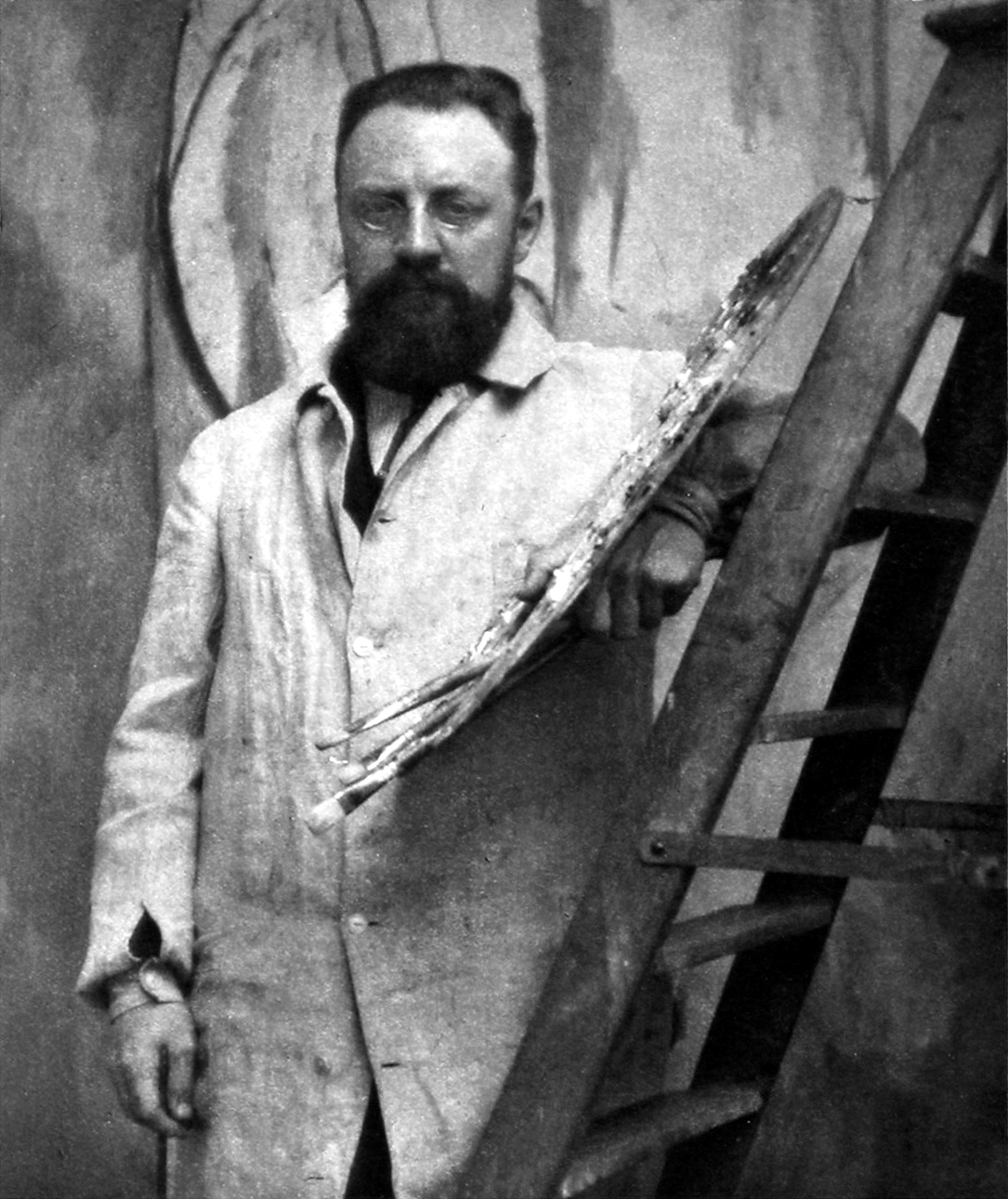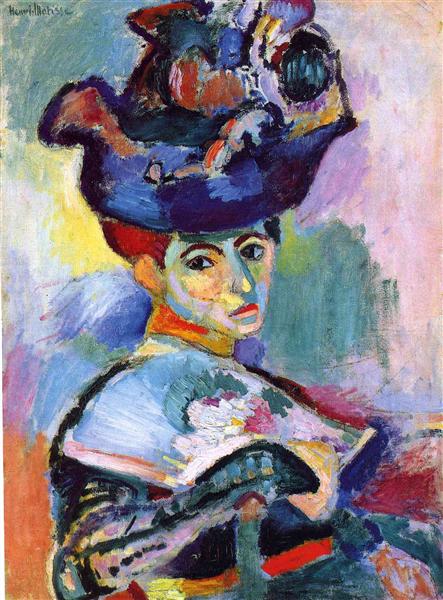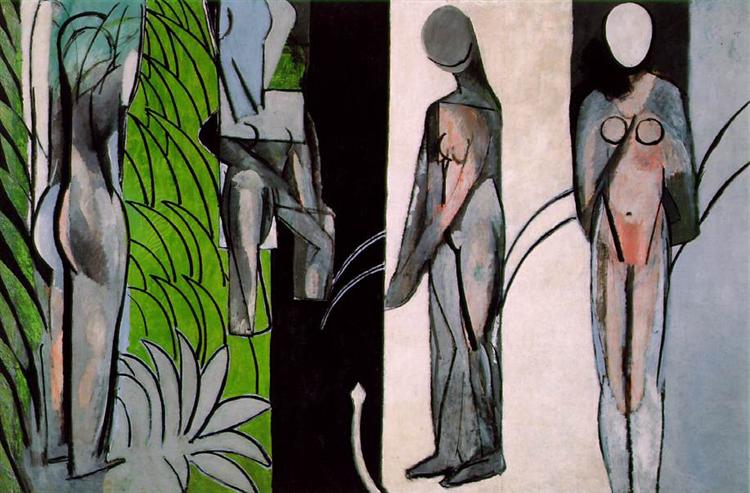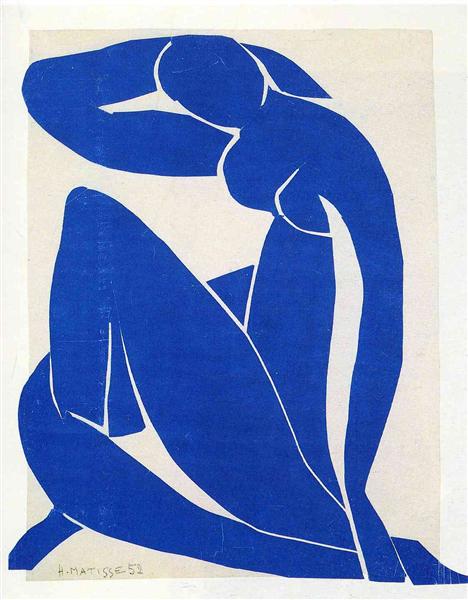le blog de guy: Matisse et le parfum des odalisques. G. Croué.
========================================================================
La leçon de musique, Henri Matisse, huile sur toile, 244,7 x 200,7 cm, 1917, Fondation Barnes,
Pensylvanie, États-Unis
Henri Matisse
« Ce que je rêve, c'est un art d'équilibre, de pureté, de tranquillité, sans sujet inquiétant ou
préoccupant, qui soit […] quelque chose d'analogue à un bon fauteuil qui délasse de ses fatigues
physiques. »
Henri Matisse (1869-1954), est un artiste peintre français chef de file du fauvisme.
Le fauvisme est un mouvement artistique né au Salon d’automne de Paris, en 1905.
Les peintres que l’on qualifiait de fauvistes, font apparaître dans leurs œuvres des
couleurs très vives parfois même pures, à peine sorties du tube. Leur volonté est de
simplifier les formes et d’utiliser la ligne droite et les courbes.
Une œuvre de Matisse en témoigne : La leçon de musique, exécutée en 1917, est
une huile sur toile qui se caractérise par des aplats (couleurs uniformes sans
variations et très homogènes). Les valeurs sont utilisées pour accroître la lumière et
les contrastes. Les couleurs sont aussi un prétexte pour attirer notre regard sur la
scène principale : tandis que certaines couleurs sont répétées dans le tableau, le
couvercle du piano est uniquement défini par un rouge proche du magenta.
Viennent ensuite les autres couleurs, notamment le vert qui symbolise la végétation
que l’on retrouve de l’autre côté de la fenêtre, dans le jardin. Les tons chauds de la
pièce s’accordent avec les tons froids du paysage. De plus, ces ambiances
colorées sont complémentaires (magenta et vert), ce qui permet de faire
progressivement glisser notre regard de l’intérieur vers l’extérieur. Ainsi, l’illusion de
la profondeur est réussie. Pour Matisse, « le peintre n’a plus à se préoccuper de
détails […]. La photographie le fait beaucoup mieux et plus vite ». La perspective
fonctionne ici uniquement grâce à la hiérarchie des plans. On comprend que
l’homme assis à gauche, le piano avec le violon et son étui à droite, sont situés au
premier plan. Au second, nous avons la femme et le jeune garçon apprenant à jouer
du piano. Serait-il en train de lire une partition de Haydn1 ? Le troisième plan se
trouve juste derrière eux, où un tableau au cadre doré est accroché tout près de la
fenêtre ouverte. De l’autre côté, une vue sur le jardin où nous avons pour quatrième
plan une femme assise en train de broder. Enfin, il y a l’arrière plan caractérisé par la
fontaine, la statue et la végétation.
Dans ce tableau où règne le calme et la tranquillité, Matisse nous peint une scène
de famille. Avec un peu d’imagination, nous pourrions presque entendre le son du
piano et les clapotis de l’eau se déversant dans le bassin.
1 Joseph Haydn est un compositeur de musique classique du XVIIIème siècle.
La leçon de musique, Henri Matisse, huile sur toile, 244,7 x 200,7 cm, 1917, Fondation Barnes,
Pensylvanie, États-Unis
==========================
Henri Matisse
Today, along with the preparations for the New Year’s Eve festivities, we are celebrating the 142nd birthday of one of the most prominent figures in modern art – Henri Matisse.
Henri-Émile-Benoît Matisse was born in Le Cateau-Cambrésis, France, on 31 December 1869. Having studied law and worked in a law office in Paris, Matisse discovered his passion for art by accident. Following an attack of appendicitis, his mother brought him art supplies during the period of convalescence. “From the moment I held the box of colours in my hands, I knew this was my life. I threw myself into it like a beast that plunges towards the thing it loves”, he recalled later.
In 1891, he began to study art, however, he strongly opposed the rigid and restrictive ways of teaching. It was again his mother who encouraged him not to follow the “rules” of art, but to listen to his emotions.
Guided by emotions, Matisse continuously experimented with styles, from neoclassicism to fauvism, from impressionism to near abstraction. He also varied the forms of artistic expression, turning from painting to sculpture, from drawing to paper cut-outs. Throughout his career, he also produced 12 illustrated books, known as “livre d’artiste”, that demonstrate his creative genius.
One of Matisse’s most famous illustrated books, Jazz, containing paper collages and his thoughts, was published during “une seconde vie”, a second life, which is how he called the last fourteen years of his life after he was diagnosed with cancer. With another chance to life, Matisse also received renewed energies to express and to create. “Painting with scissors”, as he called it, was what constituted his real self – free and liberated, Matisse said.
Matisse never tried to literally reproduce an object, but to express emotions this object projected upon him. See a full palette of emotions in his paintings and learn more about Matisse on Europeana.
=============================================
Fauvism and Henri Matisse
“To copy the objects in a still life is nothing. One must render the emotions they awaken.” – Henri Matisse
Matisse burst onto the French art in the late 19th century as leader of the Fauvist group — painters with a wild use of colors that has no basis in nature. This striking departure from the artistic conventions of his day left an indelible and colorful mark on art history. With an application of paint that is raw and unrefined, the Fauvists are celebrated as les fauves or “the wild beasts”. Matisse’s ideas on color and composition, and his art movement and philosophies continue to inspire contemporary artists today.
Born in 1869 to a family of weavers, and growing up in Bohain-en-Vermandois in northern France, Henri Matisse was heavily influenced by the bright colors and patterns of local textiles. Matisse began painting in 1889, relatively late in life (studying to be a lawyer first) and only after his mother bought him painting supplies to keep himself occupied while recovering from appendicitis. He quickly emptied his bank accounts to buy works from artists he greatly admired like Paul Cézanne and Vincent van Gogh. Both artists’ ability to build form with color and unorthodox approaches to nature would inspire Matisse throughout his artistic career.

Uniquely, Matisse employs composition and color to communicate feelings about a subject in his paintings like Woman with a Hat. In typical Matisse fashion, speed and brilliant colors dominate the painting, expressing the joy he felt in painting the woman.

Color and the combination of colors were at the center of all Fauvist works, shaping the structure and rhythm of each painting. Because colors were used by these artists to convey emotion rather than a specific scene, skies could be red, trees could be blue and a face could be a combination of greens and purples.
The result of this clashing of colors was a subject rendered by the artist’s perception of their subject rather than a true depiction of the actual physical form. Matisse’s works are as much a rendering of his mind as they are of the physical world. This blend of mind, the artist’s emotions, colors and shapes based in the physical world creates a highly personal artwork that pulls the viewer in past the surface of the canvas into the artist’s mind. Furthermore, the composition of Matisse’s works are built up through the placement of color, rather than an underlying line drawing or perspectival system.

In their obsession with expression through color and form, Fauvists are less concerned with the originality of their subject matter. In contrast, the Impressionists and Post-Impressionists occupied themselves with depictions of scenes of modern, urban life — painting the crowded cafés, boulevards and concert halls of Paris. Meanwhile, the Fauves draw directly from the world around them, and focus on portraits, interiors and landscapes with an emphasis on the visual impact of color in the painting rather than a narrative or hidden symbolism.

Ultimately, the Fauves only joined forces for a short time, with the movement lasting from 1905–1908 and across three exhibitions. Even after the dissolution of the group, Fauvism’s ideas surrounding color and subjectivity would continue to influence art movements for decades to come. In the years that followed, Matisse experimented with simple cutouts and collages, and eventually withdrew from painting entirely. His cutouts and collages started small but gradually came to occupy entire rooms and walls like the La Gerbe installation residing at the Los Angeles County Museum of Art. Matisse completed his final painting in 1951 and his cutouts were the last artworks he ever made.
Matisse’s works are part genius, whimsy and confessional as Matisse paints his personal and colorful perceptions of his interactions with the world around him. Through this process, Matisse reimagines the world around us, coloring it in such a way so that we can see it again, differently and subjectively.
================================




















